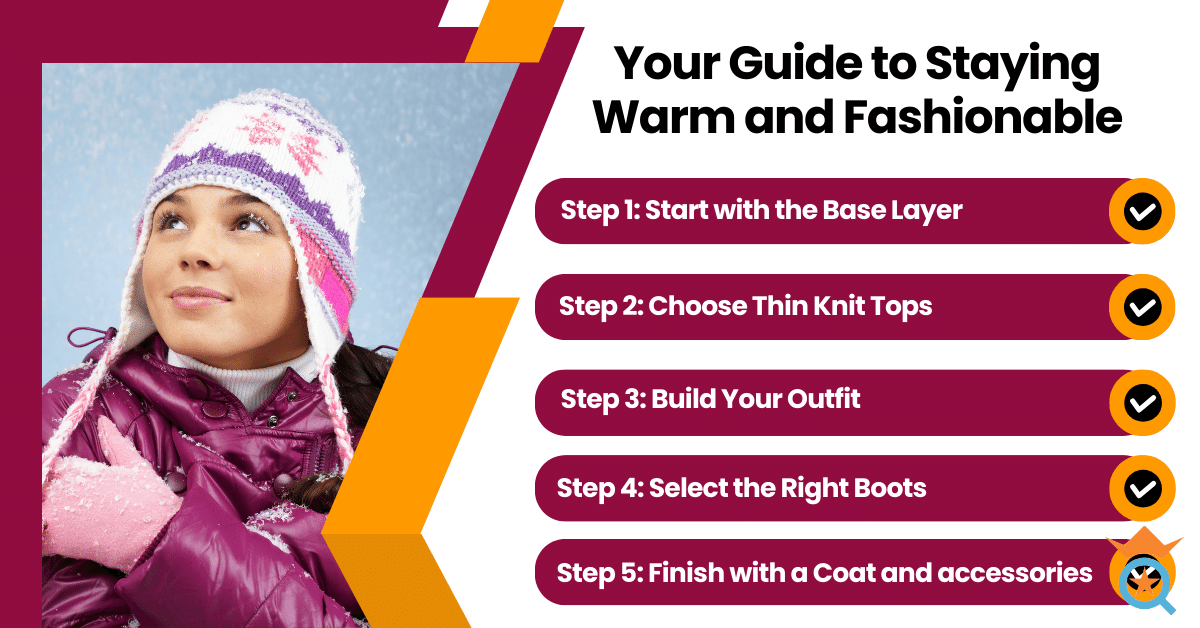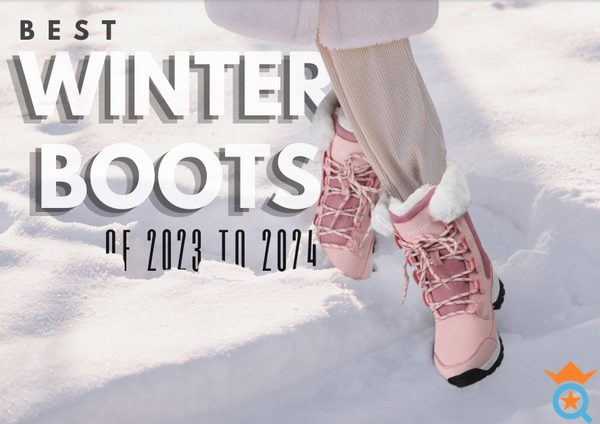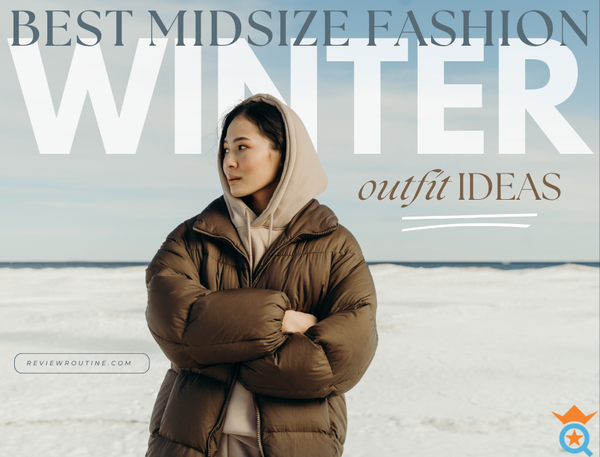Welcome to "Winter Layering 101," your essential guide to mastering the art of staying warm and stylish in cold weather. Layering is more than just piling on clothes; it's a strategic approach to combating the chill while maintaining comfort and fashion.
We'll break down the key elements - from selecting the right base layers that keep body heat close, to choosing mid-layers and insulating materials that trap warmth, all the way to the outer layer that shields against wind and wet weather.
Whether you're prepping for winter hiking, a snowy trip, or just everyday cold conditions, understanding how to effectively layer using merino wool, fleece jackets, and moisture-wicking fabrics can make all the difference. Get ready to stay warm and look great, no matter how low the mercury drops!
Your Guide to Staying Warm and Fashionable
Winter brings a unique charm to fashion, allowing you to play with different layers to create a look that's both stylish and warm. Here's a simple, step-by-step guide to mastering winter layering.
Step 1: Start with the Base Layer
The base layer is the first and most important part of winter dressing. It's the layer closest to your skin and helps keep you warm and dry.
Choosing the Right Base Layer
- Material: Look for materials that keep you warm and wick away moisture. Merino wool and synthetic fabrics are good choices. They help keep body heat in and sweat out.
- Fit: The base layer should fit snugly but not be too tight. It should feel comfortable and allow easy movement.
- Leggings and Tops: Thermal leggings should reach your ankles to keep as much warmth in as possible. Pair them with a thermal top, either sleeveless or with long sleeves, depending on how cold it is.
- Socks: Warm socks are important. Fleece-lined socks add extra warmth and are great for cold days.
- Extra Features: Some base layers have special features like odor control or seams that don’t rub against your skin. These can be useful, especially if you're active.
Starting with a good base layer is the first step in staying warm during winter. It’s simple but important for comfort and warmth, whether you're outdoors or just going about your daily activities.
Step 2: Choose Thin Knit Tops
After the base layer, the next step is adding thin knit tops. These are important for trapping heat and keeping you warm.
Picking the Right Knit Tops
- Materials: Go for natural fibers like wool or cashmere. They are good at keeping you warm and are also breathable. This means they let air through, which helps prevent overheating.
- Styles: A merino wool mock neck top or a ribbed turtleneck works well. These styles are close-fitting and help keep the warmth close to your body.
- For Sensitive Skin: If you find wool itchy, wear a thin cotton top underneath your wool or cashmere sweater. This creates a barrier between the wool and your skin, making it more comfortable.
Adding thin knit tops as your mid-layer is a simple yet effective way to enhance warmth in winter. It's an easy step that makes a big difference in staying comfortable and warm.
Step 3: Build Your Outfit
The third step in winter layering involves adding the main pieces of your outfit over the base and mid-layers.
Outfit Components
- Lower Body: Over your thermal leggings, put straight-leg jeans. This combination balances warmth and style. If you prefer a looser fit, choose a size larger in your jeans. For those wearing dresses, wool stockings over leggings offer extra warmth for your legs.
- Upper Body: On top, wear a thick sweater. This layer adds significant warmth. There are many styles to choose from, including wool and other warm materials. Pick one that feels comfortable and suits your style.
By carefully building your outfit with these layers, you ensure warmth and comfort while maintaining a style that suits you.
Step 4: Select the Right Boots
The fourth step in winter layering focuses on choosing boots, an essential part of your winter wardrobe.
How to Choose Winter Boots
- Height: Select boots that go up your leg. This helps prevent heat loss around your ankles, a common area for feeling cold.
- Material: Look for boots made of leather or weatherproof materials. These types of boots protect your feet from cold and wet conditions.
- Sturdy Boots with Socks: Another option is to wear sturdy boots with thick socks. Let a small part of the sock show above your trousers or skirt. This adds a stylish touch and extra warmth.
Selecting the right boots is crucial for keeping your feet warm and dry during winter. They complete your winter outfit and ensure comfort in cold weather.
Step 5: Finish with a Coat and accessories
The final step in winter layering is choosing the right outerwear and accessories.
Selecting Outerwear
- Coats for Colder Climates: For cold weather, a good coat is a must. Look for longer coats, like duster styles, which are both warm and flattering. They cover more of your body, helping to keep you warm.
- Parkas for Extreme Cold: In very cold conditions, a parka is a great choice. These are designed for extreme weather and provide excellent warmth.
Choosing Accessories
- Scarves: A high-quality scarf not only adds to your style but also provides extra warmth around your neck and face.
- Beanies: Choose a lined knitted beanie. The lining gives additional insulation, which is crucial for keeping your head warm.
- Gloves: Cashmere gloves are excellent for keeping your hands warm. They are soft and provide good insulation.
Completing your winter outfit with the right coat and accessories ensures maximum warmth and comfort in cold weather, while also keeping your style intact.

Wrapping Up
Winter Layering 101 is all about mastering the art of combining different layers for optimal warmth and style in cold weather. Begin with snug inner layers that keep your body heat close.
Then, add middle layers, like thin knits, which act as additional insulators without the bulk. A waterproof outer layer is crucial for protection against rain and snow, and its fill power indicates the level of warmth.
Remember, it's about using all the layers effectively. Insulating materials in each layer, from lightweight inner fabrics to more robust outer layers, are key to trapping heat. Don't hesitate to layer various materials for better insulation. Ensure your outer layers are also breathable to prevent overheating.
By carefully selecting and combining all your layers with different insulating materials, you can enjoy winter activities in comfort and style.
Popularity of Winter Outfits
Frequently Asked Questions
What is the 3-layer rule for winter?
The 3 layer rule for winter involves three types of layers: a base layer for moisture management (like long underwear), a middle insulating layer to retain body heat (such as a wool sweater), and an outer shell for protection against wind and wet weather (like a Gore-Tex jacket). This system ensures warmth, dryness, and comfort in cold conditions.
How should you layer for winter?
For effective winter layering, start with a moisture-wicking base layer to keep your skin dry. Add an insulating middle layer, like a fleece or wool sweater, for warmth. Finish with a water-resistant and windproof outer layer. Adjust the layers based on the weather, your activity level, and personal preference.
How do you style layers in the winter?
Styling layers in winter can be both functional and fashionable. Start with slim-fitting base layers and add thicker, insulating pieces like chunky knits or fleece jackets. Top it off with a stylish outer shell or coat. Play with colors and textures, and remember that layering pieces can be removed or added as needed.
How many layers should I run in cold weather?
When running in cold weather, the number of layers depends on the temperature, wind chill, and your exertion level. A general rule is to wear a sweat-wicking base layer, followed by one or two insulating layers, and a wind-resistant outer layer. Adapt the layers to avoid overheating or excessive sweating.
Is Uniqlo HeatTech good for winter?
Uniqlo HeatTech is a popular choice for winter layering due to its lightweight, heat-retaining, and moisture-wicking properties. It's effective as a base layer in colder weather, especially when layered with other insulating materials and an outer shell. Its effectiveness varies with different levels of cold and personal comfort needs.








